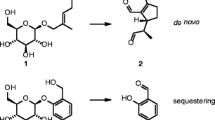Abstract
All stages in the life cycle ofAcraea horta (L.) (Lepidoptera: Acraeinae) were found to release hydrogen cyanide (HCN) from their crushed tissues, and the source of cyanogenesis was present in the hemolymph of adults and larvae. Comparison with standards on thin-layer chromatograms (TLC) revealed the presence in adults of gynocardin, a cyclopentenyl cyanoglycoside also produced by the larval food plant,Kiggelaria africana L. (Flacourtiaceae). Analysis of adults reared on plant species (Passifloraceae) containing gynocardin and/or other cyanoglycosides suggested selective uptake of gynocardin by the larvae. This is the first demonstration of a cyanoglycoside, other than the acyclic linamarin and lotaustralin, occurring in Lepidoptera and the first evidence for the storage byAcraea butterflies of a plant-produced allelochemical. Possible implications for the understanding of the evolution of acraeine host choice are discussed.
Similar content being viewed by others
References
Ackery, P.R. 1987. Diversity and phantom competition in African acraeine butterflies.Biol. J. Linn. Soc. 30:291–297.
Ackery, P.R. 1988. Hostplants and classification: A review of nymphalid butterflies.Biol. J. Linn. Soc. 33:95–203.
Bernays, E.A., andChapman, R.F. 1978. Plant chemistry and acridoid feeding behaviour, pp. 99–141,in J.B. Harborne (ed.). Biochemical Aspects of Plant and Animal Coevolution. Academic Press, New York.
Brower, L.P., andBrower, J.V.Z. 1964. Birds, butterflies and plant poisons: A study in ecological chemistry.Zoologica (N.Y.) 49:137–159.
Conn, E.E. 1979. Cyanide and cyanogenic glycosides, pp. 387–412,in G.A. Rosenthal, and D.H. Janzen (eds.). Herbivores, their Interaction with Secondary Plant Metabolites. Academic Press, New York.
Conn, E.E. 1981. Biosynthesis of cyanogenic glycosides, pp. 183–196,in B. Vennesland, E.E. Conn, C.J. Knowles, J. Westley, and F. Wissing (eds.). Cyanide in Biology. Academic Press, London.
Davis, R.H., andNahrstedt, A. 1979. Linamarin and lotaustralin as the source of cyanide inZygaena filipendulae L. (Lepidoptera).Comp. Biochem. Physiol. 64B:395–397.
Davis, R.H., andNahrstedt, A. 1982. Occurrence and variation of the cyanogenic glucosides linamarin and lotaustralin in species of the Zygaenidae (Insecta: Lepidoptera).Comp. Biochem. Physiol. 716:329–332.
Davis, R.H., andNahrstedt, A. 1985. Cyanogenesis in insects, pp. 635–654,in G.A. Kerkut and L.I. Gilbert (eds.). Comprehensive Insect Physiology, Biochemistry and Pharmacology, Vol. II. Pergamon Press, Oxford.
Ehrlich, P.R., andRaven, P.H. 1965. Butterflies and plants: A study in coevolution.Evolution 18:586–608.
Gibbs, R.D. 1974. Chemotaxonomy of Flowering Plants. Vol. I. McGill-Queens University Press, Montreal.
Jones, D.A., Parsons, K., andRothschild, M. 1962. Release of hydrocyanic acid from crushed tissues of all stages in the life cycle of species of the Zygaenidae (Lepidoptera).Nature 193:52–53.
Nahrstedt, A., andDavis, R.H. 1981. The occurrence of the cyanoglucosides linamarin and lotaustralin inAcraea andHeliconius butterflies.Comp. Biochem. Physiol. 68B:575–577.
Nahrstedt, A., andDavis, R.H. 1983. Occurrence, variation and biosynthesis of the cyanogenic glucosides linamarin and lotaustralin in species of theHeliconiini (Insecta: Lepidoptera).Comp. Biochem. Physiol. 75B:65–73.
Nahrstedt, A., andDavis, R.H. 1986. Uptake of linamarin and lotaustralin from their foodplant by larvae ofZygaena trifolii.Photochemistry 25(10):2299–2302.
Nahrstedt, A., Norbert, E., andZinmeister, H. 1981. Methods of liberating and estimating hydrocyanic acid from cyanogenic plant material, pp. 461–471,in B. Vennesland, E.E. Conn, C.J. Knowles, J. Westley, and F. Wissing (eds.). Cyanide in Biology. Academic Press, London.
Owen, D.F. (1970) Mimetic polymorphism and the palatability spectrum.Oikos 21:333–336.
Owen, D.F., andChanter, D.O. 1969. Population biology of tropical African butterflies. Sex ratio and genetic variation inAcraea encedon.J. ZooL., London 157:345–374.
Pennington, K.M. 1978. Acraeidaein Butterflies of Southern Africa. C.G.C. Dickson and D.M. Kroon (eds.). A.D. Donker, Johannesburg.
Pierre, J. 1984. Systématique Evolutive, Cladistique et Mimetisme chez les Lepidoptères du genreAcraea (Nymphalidae). Unpublished PhD thesis. University of Paris.
Raubenheimer, D. 1987. Cyanogenesis and the feeding preference ofAcraea horta (L.) (Lepidoptera: Acraeinae). Unpublished MSc thesis. University of Cape Town.
Raubenheimer, D., andElsworth, J.F. 1988. Gynocardin from the leaves ofKiggelaria africana.J. Nat. Prod. 51(4):779.
Rothschild, M. 1971. Speculations about mimicry with Henry Ford. pp. 202–223,in E.R. Creed (eds.). Ecological Genetics and Evolution. Blackwell Scientific Publications, Oxford.
Rothschild, M. 1972. Secondary plant substances and warning colouration in insects.Symp. R. Entomol. Soc. London 6:59–83.
Seigler, D.S. 1975. Isolation and characterisation of naturally occurring cyanogenic compounds.Phytochemistry 14:9–29.
Smiley, J.T. 1985. Are chemical barriers necessary for evolution of butterfly-plant associations?Oecologia (Berlin) 65:580–583.
Spencer, K.C., andSeigler, D.S. 1982. Tetraphyllin B and epi-tetraphyllin B fromAdenia glauca Schinz.Onderstepoort J. Vet. Res. 49:137–138.
Steyn, D.G. 1934. Toxicology of Plants in South Africa. South African Central News Agency Ltd. Cape Town.
Tantisewie, B., Ruijgrok, H.W.L., andHegnauer, R. 1969. Die Verbreitung der Blausaure bei den Kormophyten.Pharm. Weekblad 104:1341–1355.
Von Euw, J., Fishelson, L., Parsons, J.A., Reichstein, T., andRothschild, M. 1967. Cardenolides (heart poisons) in a grasshopper feeding on milkweeds.Nature 214:35–39.
Wiklund, C. 1975. The evolutionary relationship between adult oviposition preferences and larval host plant range inPapilio machaon.Oecologia 18:185–197.
Author information
Authors and Affiliations
Rights and permissions
About this article
Cite this article
Raubenheimer, D. Cyanoglycoside gynocardin fromAcraea horta (L.) (Lepidoptera: Acraeinae). J Chem Ecol 15, 2177–2189 (1989). https://doi.org/10.1007/BF01014108
Received:
Accepted:
Issue Date:
DOI: https://doi.org/10.1007/BF01014108




